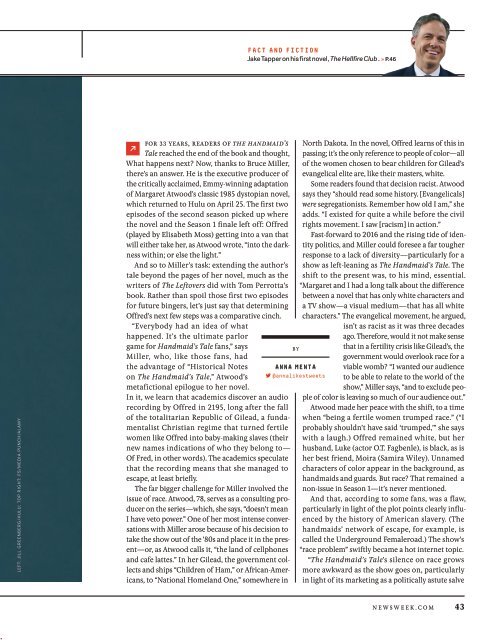You also want an ePaper? Increase the reach of your titles
YUMPU automatically turns print PDFs into web optimized ePapers that Google loves.
FACT AND FICTION<br />
Jake Tapper on his first novel, The Hellfire Club . » P.46<br />
LEFT: JILL GREENBERG/HULU; TOP RIGHT: FS/MEDIA PUNCH/ALAMY<br />
for 33 years, readers of the handmaid’s<br />
Tale reached the end of the book and thought,<br />
What happens next? Now, thanks to Bruce Miller,<br />
there’s an answer. He is the executive producer of<br />
the critically acclaimed, Emmy- winning adaptation<br />
of Margaret Atwood’s classic 1985 dystopian novel,<br />
which returned to Hulu on April 25. The first two<br />
episodes of the second season picked up where<br />
the novel and the Season 1 finale left off: Offred<br />
(played by Elisabeth Moss) getting into a van that<br />
will either take her, as Atwood wrote, “into the darkness<br />
within; or else the light.”<br />
And so to Miller’s task: extending the author’s<br />
tale beyond the pages of her novel, much as the<br />
writers of The Leftovers did with Tom Perrotta’s<br />
book. Rather than spoil those first two episodes<br />
for future bingers, let’s just say that determining<br />
Offred’s next few steps was a comparative cinch.<br />
“Everybody had an idea of what<br />
happened. It’s the ultimate parlor<br />
game for Handmaid’s Tale fans,” says<br />
Miller, who, like those fans, had<br />
the advantage of “Historical Notes<br />
on The Handmaid’s Tale,” Atwood’s<br />
metafictional epilogue to her novel.<br />
In it, we learn that academics discover an audio<br />
recording by Offred in 2195, long after the fall<br />
of the totalitarian Republic of Gilead, a fundamentalist<br />
Christian regime that turned fertile<br />
women like Offred into baby-making slaves (their<br />
new names indications of who they belong to—<br />
Of Fred, in other words). The academics speculate<br />
that the recording means that she managed to<br />
escape, at least briefly.<br />
The far bigger challenge for Miller involved the<br />
issue of race. Atwood, 78, serves as a consulting producer<br />
on the series—which, she says, “doesn’t mean<br />
I have veto power.” One of her most intense conversations<br />
with Miller arose because of his decision to<br />
take the show out of the ’80s and place it in the present—or,<br />
as Atwood calls it, “the land of cellphones<br />
and cafe lattes.” In her Gilead, the government collects<br />
and ships “Children of Ham,” or African-Americans,<br />
to “National Homeland One,” somewhere in<br />
B Y<br />
North Dakota. In the novel, Offred learns of this in<br />
passing; it’s the only reference to people of color—all<br />
of the women chosen to bear children for Gilead’s<br />
evangelical elite are, like their masters, white.<br />
Some readers found that decision racist. Atwood<br />
says they “should read some history. [Evangelicals]<br />
were segregationists. Remember how old I am,” she<br />
adds. “I existed for quite a while before the civil<br />
rights movement. I saw [racism] in action.”<br />
Fast-forward to 2016 and the rising tide of identity<br />
politics, and Miller could foresee a far tougher<br />
response to a lack of diversity—particularly for a<br />
show as left-leaning as The Handmaid’s Tale. The<br />
shift to the present was, to his mind, essential.<br />
“Margaret and I had a long talk about the difference<br />
between a novel that has only white characters and<br />
a TV show—a visual medium—that has all white<br />
characters.” The evangelical movement, he argued,<br />
isn’t as racist as it was three decades<br />
ago. Therefore, would it not make sense<br />
that in a fertility crisis like Gilead’s, the<br />
government would overlook race for a<br />
viable womb? “I wanted our audience<br />
to be able to relate to the world of the<br />
show,” Miller says, “and to exclude people<br />
of color is leaving so much of our audience out.”<br />
Atwood made her peace with the shift, to a time<br />
when “being a fertile women trumped race.” (“I<br />
probably shouldn’t have said ‘trumped,’” she says<br />
with a laugh.) Offred remained white, but her<br />
husband, Luke (actor O.T. Fagbenle), is black, as is<br />
her best friend, Moira (Samira Wiley). Unnamed<br />
characters of color appear in the background, as<br />
handmaids and guards. But race? That remained a<br />
non-issue in Season 1—it’s never mentioned.<br />
And that, according to some fans, was a flaw,<br />
particularly in light of the plot points clearly influenced<br />
by the history of American slavery. (The<br />
handmaids’ network of escape, for example, is<br />
called the Underground Femaleroad.) The show’s<br />
“race problem” swiftly became a hot internet topic.<br />
“The Handmaid’s Tale’s silence on race grows<br />
more awkward as the show goes on, particularly<br />
in light of its marketing as a politically astute salve<br />
ANNA MENTA<br />
@annalikestweets<br />
NEWSWEEK.COM<br />
43


